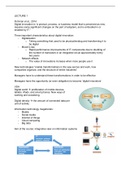LECTURE 1
Fichman et al., 2014
Digital innovation is “a product, process, or business model that is perceived as new,
requires some significant changes on the part of adopters, and is embodied in or
enabled by IT.”
Three important characteristics about digital innovation:
- Digitalization
o Taking something that used to be physical/analog and transforming it to
be digital
- Moore’s law
o Rapid performance improvements of IT components due to doubling of
the number of transistors in an integrated circuit approximately every
two years
- Network effects
o The value of innovations increase when more people use it
New technologies “enable transformations in the way we live and work, how
companies organize, and the structure of entire industries”
Managers have to understand these transformations in order to be effective
Managers have the opportunity (or even obligation) to become ‘digital innovators’
VSH
Digital world proliferation of mobile devices,
tablets, iPads, and smart phones. New ways of
working and socializing.
Digital density the amount of connected data per
unit of activity
Information technology megatrends:
- Mobile
- Social media
- Internet of things
- Cloud computing
- Big data
Aim of the course: integrative view on information systems
,Relation between data, information, knowledge
Information Systems (IS):
Combinations of hardware, software and
telecommunications networks that people build and use to
collect, create, and distribute useful data in organizational
settings
Primary function: to convert data into information
Information Technology (IT):
o Hardware, software, networks
o One of the components of an IS
o Next to people and organization
Organizational information processing
Increasing need for information
o Markets increasingly complex, dynamic, globalized, etc.
Increasing availability of data
o Especially in digital form big data
Technological innovation
Computers, internet, mobile, smart devices, etc.
o “Relatively cheap and increasingly easy-to-use world-wide digital
infrastructure of computers, mobile devices, broadband network
connections, and advanced application platforms” (Fichman et al.,
2014)
How to deal with all that information? (Galbraith, 1974)
- Reduce need for information processing
o Create buffers, reduce coordination
o Feasible in today’s complex, uncertain, globalizing environment?
- Increase capacity for information processing
o Information Systems
o Technological capabilities
Increased capacity for information processing.
,General developments in IT:
• Digital innovation: digitalization, increasing capacity, network effects
Hardware: smaller, processing capacity, storage capacity, more functions,
networked
Software: smarter, modular, interconnected
Networks: larger scope, mobile, transmission capacity, interconnected
The information age: big data
Digital innovation has exponentially increased the amount of available information,
and our capacity to store and transmit it
Challenge is:
- To make sense of all that data (turn it into information)
- To derive value from all the untapped data (only a very small percentage is
analyzed)
Information systems and performance are related in three ways (Valacich &
Schneider)
1. Automate: doing things more efficiently, accurately, and consistently
2. Learning: doing things better, based on available information (informate)
3. Supporting strategy: doing things smarter, fundamentally redefine business
and industry processes and relationships (transform)
So, technology is not a magic bullet (Markus, 2004)
• Implementing a new technology will not improve performance all by itself
Technological determinism
Reason for failure for many IS projects
• Managing IS requires an integrative vision
Of technology, organization, people
Aligning Business and IT
Socio-technical approach
LECTURE 2
787 Dreamliner: Game changer
cutting edge technologies, cutting edge knowledge
From supply chain to supply network:
Supply network
- From ‘build to print’ to ‘build to performance’
- Final assembly reduced from 30 days to 3 days
50 Tier 1 suppliers: strategic partners
- Responsible for engineering and manufacturing of sub-parts of aircraft
- Responsible for coordinating with tier 2 and tier 3 suppliers
, designed and built with global outsourcing partners from all over the world
focus on large-scale system integration
A new business strategy:
Focus on innovation
Knowledge- and resource-sharing company
Core competencies: integration of large, complex systems
From vertical organization to virtual network: focus on global outsourcing
A new information systems strategy, IS strategy objectives:
o IT-enabled virtual integration
o Global collaboration environment
o Virtualize as much of the process as possible
o Videoconferencing, collaboration tools, etc.
o Digital mockup: virtual design and modeling of a lot of parts and the
whole plane, instead of physical prototypes
o Phase out legacy systems
o Decentralization of IT
Aligning business and IS strategies:
- Product innovation together with process innovation
o New aircraft, new manufacturing process
o Suppliers do manufacture and part of engineering
- Redesigning both business strategy and IS strategy
o Facilitating breakthrough innovation in manufacturing and SCM
processes
- IS crucial in strategy concerning supply chain and manufacturing
o Strategic value of IS
nightmare, terrible supply chain management
overweight, overheated, etc.
Strategic value of IS:





